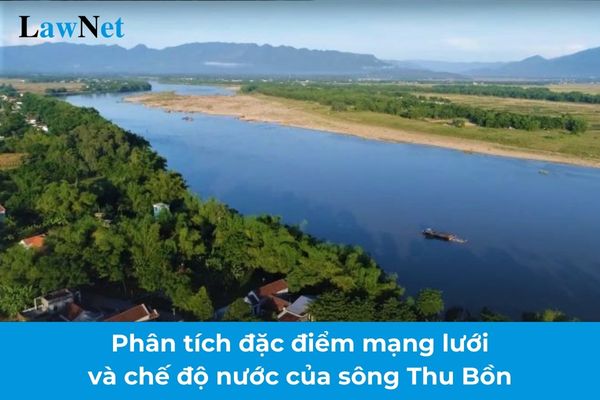Vietnam: What are the guidelines for the analysis of network characteristics and hydrological regime of the Thu Bon River? What are the minimum requirements regarding facilities for auxiliary rooms in lower secondary schools?
What are the guidelines for the analysis of network characteristics and hydrological regime of the Thu Bon River?
The Thu Bon River system is one of the major and important rivers in Central Vietnam, noted for its unique river network characteristics and hydrological regime.
Below is an analysis of the network characteristics and hydrological regime of the Thu Bon River.
| 1. Network Characteristics - Tributary Scale: + The Thu Bon River system consists of 78 tributaries with lengths exceeding 10 km, creating a complex and diverse river network. - Characteristics of Rivers and Streams: + The rivers and streams within the system are typically short and steep, characteristic of the highland terrain in Central Vietnam. + Water from the tributaries flows down quickly, creating strong currents, contributing to the sudden nature of floods. - Shape of the Network: + The river network is fan-shaped, with branches evenly distributed from the highland areas down to the plains, converging into the main course of the Thu Bon River. 2. Water Regime The Thu Bon River system has typical hydrological regime of Central Vietnam, with two distinct seasons: the flood season and the dry season. a. Flood Season (October to December) - Cause: + The flood season coincides with the autumn to winter rainy season and the storm season in Central Vietnam when the rainfall is concentrated. - Characteristics: + Water volume in the flood season accounts for about 65% of the total annual water volume. + Floods in the Thu Bon River often rise quickly and suddenly, especially during storms or prolonged heavy rain, posing risks of flash floods and inundation in downstream regions. b. Dry Season (January to September) - Cause: + The dry season occurs during the arid period in Central Vietnam when rainfall drops sharply. - Characteristics: + Water volume in the dry season accounts for about 35% of the total annual water volume. + Water flow decreases significantly, affecting the water supply for agricultural production and livelihoods. 3. Conclusion The Thu Bon River network, with its fan shape, short and steep tributaries, combined with clearly differentiated hydrological regime, has created fast, strong, and easily fluctuating water flows. These features not only reflect the natural conditions of Central Vietnam but also present significant challenges in water resource management, flood prevention, and ensuring water supply during the dry season. |
Note: The content is for reference purposes only.

What are the guidelines for the analysis of network characteristics and hydrological regime of the Thu Bon River? What are the minimum requirements regarding facilities for auxiliary rooms in lower secondary schools in Vietnam? (Image from the Internet)
What are the minimum requirements regarding facilities for auxiliary rooms in lower secondary schools in Vietnam?
Under Clause 4, Article 14 of the Regulation issued with Circular 13/2020/TT-BGDDT, the minimum requirements regarding facilities for auxiliary rooms in lower secondary schools in Vietnam are as follows:
- Meeting room for the entire officials, teachers and staff of the school: at least 1; fully equipped as per the law;
- Room for specialized teams: at least 1 room shared by all specialized teams; in schools with more than 30 classes: at least 2 rooms; fully equipped as per the law;
- Medical room: at least 1; medicine cabinets with essential medicines, first aid equipment and hospital beds;
- Storage: at least 1; to store general equipment and school supplies;
- Student parking lot: installed with roof; parking space for students with disabilities are located near the entrance;
- Student sanitary areas: situated along functional rooms; separated by gender; guaranteed accessibility for students with disability; number of equipment: 1 urinal stand, 1 toilet bowl and 1 wash-basin for every 30 boys (in case of urinal trenches, 0.6 m in length for every 30 boys) with walls/partitions separating urinal stands from toilet bowls; 1 toilet bowl and 1 wash-basin for every 20 girls. In case of separate sanitary areas, situate in location that is convenient and not affecting the environment;
- Gates and fences: school and school cluster premises must be separated from the outside by sturdy and safe fences (walls or trees); gates of schools and school clusters must be reinforced and firm to hold school name signs.
What are the purposes of applying standard facilities in lower secondary schools in Vietnam?
Under Article 3 of the Regulation issued with Circular 13/2020/TT-BGDDT, the purposes of applying standard facilities in lower secondary schools in Vietnam are as follows:
- Determining minimum standards of facilities of educational institutions to guarantee conditions for implementing education programs.
- Determining level of satisfaction of standard facilities to recognize education accreditation and national standards of educational institutions.
- Planning network of educational institutions.
- Determining standards and use of specialized area within utilities operating in education and training sector specified in Decree No. 152/2017/ND-CP.

